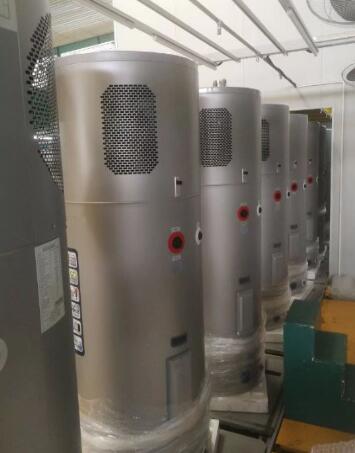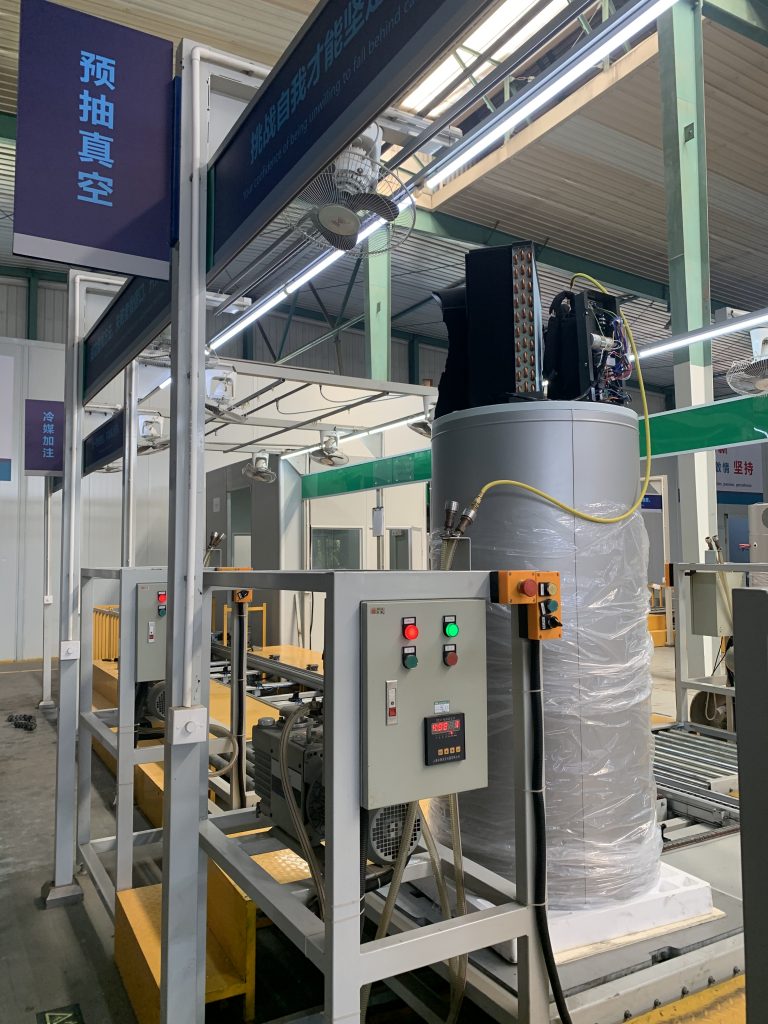Le pompe di calore aria-acqua R32 Split DC inverter esistono da molti anni e forniscono opzioni di riscaldamento efficienti, affidabili e a prezzi ragionevoli per i proprietari di casa. Queste strutture utilizzano uno scambiatore di calore aria-acqua per riscaldare l'acqua, che viene poi convogliata all'interno dell'abitazione e utilizzata per il riscaldamento e l'acqua calda. La macchina è alimentata da un compressore a inverter DC, che può essere regolato in base alle esigenze di riscaldamento dell'abitazione, con conseguente risparmio di energia elettrica. Le pompe di calore aria-acqua split DC inverter offrono una vasta gamma di vantaggi, tra cui la riduzione della bolletta elettrica, l'aumento dell'efficienza dell'aria e la riduzione dei livelli di rumore.

Definizione di pompa di calore aria/acqua split DC inverter
con due circuiti Una pompa di calore aria-acqua con inverter DC con due circuiti è un tipo di apparecchio di riscaldamento composto da un'unità esterna e da una o due unità interne. L'unità esterna incorpora un compressore e un condensatore, mentre le unità interne incorporano un evaporatore, un inverter CC e/o un espansore.
I due circuiti si riferiscono alla capacità del sistema di controllare in modo indipendente l'uscita di ciascuno dei suoi componenti, consentendo una maggiore efficienza energetica e un migliore controllo della temperatura dell'aria interna.
L'inverter CC consente il funzionamento a velocità variabile del compressore, permettendo di variare il flusso di refrigerante e la velocità variabile dell'espansore, consentendo così un'ampia gamma di temperature di uscita.
Richiedono inoltre una minore manutenzione rispetto a un sistema di caldaie tradizionali, il che li rende una scelta ideale per molti proprietari di case. Inoltre, possono essere facilmente integrati nei sistemi esistenti e possono essere installati in una varietà di luoghi.
Le pompe di calore aria-acqua split DC inverter sono un ottimo modo per ridurre i consumi energetici, migliorare il comfort della vostra casa e risparmiare sulla bolletta energetica.
I vantaggi della pompa di calore aria-acqua Split DC inverter
- Maggiore efficienza: Funzionando a velocità variabile, una pompa di calore aria-acqua split DC inverter è in grado di aumentare l'efficienza del suo funzionamento. Ciò consente di ridurre i consumi energetici, con conseguente diminuzione delle bollette.
- Funzionamento silenzioso: Grazie alle basse velocità di funzionamento, una pompa di calore aria-acqua split DC inverter funziona in modo molto più silenzioso rispetto alle pompe di calore tradizionali. Ciò consente di ottenere un ambiente più confortevole.
- Maggiore durata: Controllando le velocità del sistema, una pompa di calore aria-acqua split DC inverter è in grado di funzionare per periodi di tempo più lunghi, il che significa che la durata del sistema è maggiore. Questo può contribuire ad aumentare il ritorno sull'investimento.
- Controllo avanzato: Le pompe di calore split DC inverter sono dotate di un sistema di controllo avanzato che consente di gestire con precisione la temperatura dell'ambiente. In questo modo è possibile garantire un ambiente confortevole, contribuendo al contempo a ridurre il consumo energetico.
- Riscaldamento e raffreddamento: Una pompa di calore aria-acqua split DC inverter è in grado di riscaldare e raffreddare lo spazio. In questo modo si può risparmiare consentendo di utilizzare lo stesso sistema per le esigenze di riscaldamento e raffreddamento.
Pompa di calore aria-acqua Split DC Inverter a confronto
Confronto tra pompe di calore aria-acqua Split DC Inverter.
Efficienza: Le pompe di calore Split DC Inverter utilizzano la tecnologia dell'inverter, che offre rendimenti più elevati rispetto ai compressori tradizionali.
Rumorosità: Le pompe di calore Split DC Inverter funzionano in modo silenzioso, producendo un rumore minimo rispetto ai sistemi tradizionali.
Installazione: Le pompe di calore Split DC Inverter sono semplici da installare e occupano meno spazio in casa.
Costo di esercizio: le pompe di calore Split DC Inverter offrono costi di esercizio ridotti grazie alla loro efficienza energetica.
Durata di vita: Le pompe di calore Split DC Inverter offrono una durata maggiore grazie all'uso della tecnologia inverter.
Versatilità: I sistemi Split DC Inverter possono fornire riscaldamento, raffreddamento e acqua calda a intere famiglie.
Manutenzione: Le pompe di calore Split DC Inverter richiedono una manutenzione minima, grazie alla tecnologia avanzata dell'inverter.
Ambiente: Le pompe di calore Split DC Inverter utilizzano un refrigerante più rispettoso dell'ambiente rispetto ai sistemi tradizionali.
Capacità di riscaldamento dell'acqua: Le pompe di calore Split DC Inverter forniscono rapidamente acqua calda con un consumo energetico minimo.
Controllo della temperatura: Le pompe di calore Split DC Inverter offrono un controllo preciso e regolabile della temperatura.
Controllo del clima: Le pompe di calore Split DC Inverter sono in grado di mantenere una temperatura costante nelle abitazioni per tutto l'anno.
Sicurezza: Le pompe di calore Split DC Inverter sono dotate di funzioni di sicurezza per proteggere il sistema da eventuali danni.
Costo della pompa di calore aria-acqua Split DC Inverter
Il costo di un sistema split DC inverter a pompa di calore aria-acqua può variare notevolmente a seconda delle dimensioni e del tipo di sistema. In generale, questi sistemi sono più costosi dei tradizionali sistemi aria-aria o aria-acqua, con prezzi che vanno da circa $3.000 a oltre $7.000.
Molti dei componenti che compongono un sistema split, tra cui l'unità esterna, l'unità interna, i collegamenti interni e il cablaggio, devono essere installati professionalmente, il che può comportare un costo aggiuntivo per la bolletta complessiva.
L'efficienza, il risparmio e il livello di rumorosità possono differire tra i vari modelli e marchi, quindi è importante considerare tutti questi fattori per determinare il sistema migliore per voi.
Installazione di una pompa di calore aria-acqua Split DC inverter
- Disattivare l'elettricità dall'interruttore del circuito.
- Collegare le guaine, i raccordi e i cavi di alimentazione della pompa di calore alla scatola di giunzione elettrica.
- Montare l'inverter e collegarlo alla pompa di calore e al pannello di controllo.
- Collegare i fili e le guaine al pannello di controllo.
- Accendere l'elettricità e verificare il flusso di corrente con un multimetro.
- Installare le tubature e gli impianti.
- Collegare la pompa di calore ai serbatoi dell'acqua calda.
- Collegare l'unità di condensazione alla canalizzazione esistente.
- Collegare le tubazioni di uscita e di ritorno all'inverter.
- Avviare la pompa di calore aria-acqua split DC inverter.
- Verificare il corretto funzionamento dell'unità e assicurarsi che tutte le funzioni di sicurezza funzionino correttamente.
- In alcune installazioni potrebbe essere necessario un sistema di backup. Consultare un tecnico qualificato per completare questa configurazione.
- Chiedere a un tecnico certificato di controllare accuratamente il funzionamento del sistema.
- Chiedete al vostro appaltatore di regolare le impostazioni necessarie per ottenere un'efficienza energetica ottimale e temperature confortevoli.
Manutenzione della pompa di calore aria-acqua Split DC inverter
La manutenzione di una pompa di calore aria-acqua DC inverter tagliata dovrebbe comprendere l'ispezione dei componenti di trasferimento per verificare l'usura, il controllo di eventuali perdite e la pulizia o la sostituzione dei filtri. Inoltre, il dispositivo della pompa di calore deve essere ispezionato in molti casi per individuare eventuali problemi di efficienza o di sicurezza.
Ciò può includere la verifica periodica dei livelli di temperatura e pressione del sistema, il controllo del corretto funzionamento dello scarico della condensa e l'ispezione dei condotti dell'aria e delle linee del refrigerante.
Inoltre, la manutenzione deve prevedere il controllo regolare delle prestazioni del compressore e degli altri componenti. A seconda del produttore, potrebbero essere necessari ulteriori interventi di manutenzione.
Potrebbe piacerti:










